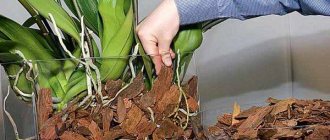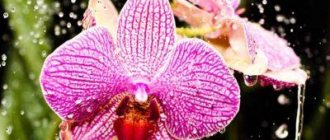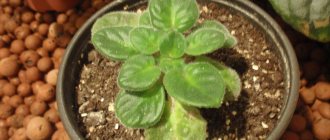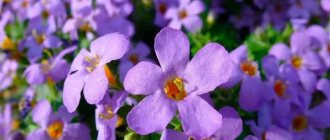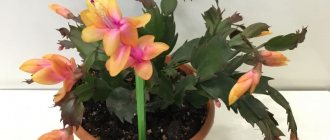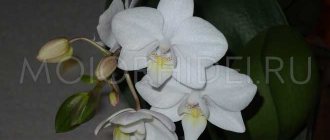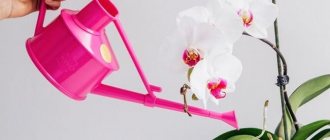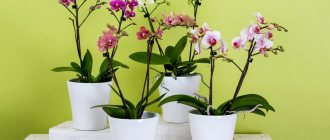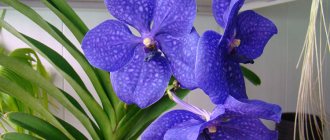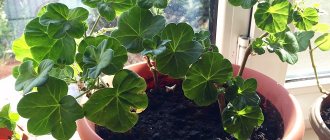A flowering plant such as an orchid is represented by a wide variety of varieties, but phalaenopsis is more adapted to growing at home. This plant is quite unpretentious and, if you care for it correctly, will bloom for about six months.
Proper care of phalaenopsis orchids means that you need not only to create optimal conditions for its maintenance and water it correctly, but also to carefully approach the issue of choosing and introducing fertilizer.
When to feed a phalaenopsis orchid?
The optimal time to fertilize a phalaenopsis orchid is 21-30 days after transplantation. To do this, they use special complex products, which include nutritional components and elements that stimulate the process of cell regeneration and activation of their growth. Succinic acid in the form of a solution, which is a growth regulator, is a good choice.
It is recommended that the first feeding of phalaenopsis at home be carried out using the foliar (leaf) method using spraying, since this way the plant will receive a larger amount of nutrients.
Nutrient deficiencies
You can regularly fertilize an orchid , but it will still suffer from a lack of one or another substance.
Why is this happening? The main reason lies in the suboptimal acidity of the substrate, determined by pH.
The optimal value for most types of orchids is between 5.5 and 6.5 pH . When the pH is below 5 or above 6.8 pH, an unfavorable environment is formed inside the substrate and the orchid root system stops consuming many nutrients.
In acidic soils (pH 4.0-5.5), iron, aluminum and manganese are in forms available to plants, and their concentrations reach toxic levels. At the same time, the supply of phosphorus, potassium, sulfur, calcium, magnesium, and molybdenum to plants is difficult.
In alkaline conditions (pH 7.5-8.5), iron, manganese, phosphorus, copper, zinc, boron and most trace elements become less available to plants.
What affects the decrease or increase in pH of the substrate?
From frequent watering, many organic components of the substrate begin to decompose, and its pH decreases. This indicator increases due to frequent fertilizers or watering with (hard) tap water.
The roots of many epiphytic orchids are very sensitive to various types of potassium, phosphorus, etc. salts contained in fertilizers and exposure to highly concentrated fertilizer can cause burns.
REMEMBER that ordinary fertilizers for indoor plants are oriented towards action in ordinary soil and for absorption by ordinary, NOT EPIPHYTIC roots, so their main drawback is the rapid salinization of the substrate, which creates an unfavorable environment for the root system of orchids inside the pots, in especially sad cases leading to their mass die-off.
What fertilizer should I use?
When using fertilizer for phalaenopsis, you need to take into account the season. In winter and summer, the flower should be fed no more than once a month, and in autumn and spring - twice a month, provided that the orchid is not in the dormant stage.
There are special fertilizers for phalaenopsis orchids that contain the optimal amount of microelements, which allows you to avoid the salinity of the substrates.
If it is not possible to purchase such a fertilizer for phalaenopsis, then you can use the usual ones, which are intended for indoor flowers. It just needs to be less concentrated.
To improve the process of photosynthesis, as well as carbohydrate and protein metabolism for a phalaenopsis orchid, you should feed it with fertilizer containing phosphorus-containing substances. When entering the active growing season, the plant consumes many nutrients, due to which leaves and roots develop. For this reason, it requires large amounts of nitrogen-containing substances.
When choosing fertilizer for phalaenopsis, you need to remember such important microelements as potassium and phosphorus, which significantly affect the process of formation of buds and flower stalks. If there are enough of them, the color tone of the plant will become more pronounced, and the peduncle will develop well.
Problems and difficulties
When growing such an interesting tropical plant in an apartment, naturally, sometimes some difficulties arise, for example:
An orchid does not want to bloom - this may be due to too much watering or improper watering.
- If you water a flower in a pot that has good drainage, the water will quickly spill and the soil will not have time to get wet and saturated with moisture, that is, the plant simply does not have enough water.
- If there is poor drainage and the soil is heavily intertwined with roots, then with constant watering in the pot, the root system will begin to rot - there is no time for flowering.
Therefore, it is necessary to water using the immersion method. The peduncle turns yellow - it would seem that the peduncle has begun to grow, everything is fine, we are waiting for the appearance of buds and flowers, however, it may happen that it suddenly stops growing and begins to turn yellow and dry out.
The reason may be that the plant is simply not yet ready for flowering, which we artificially provoked (we created various stresses), it devoted all its strength to releasing the flower arrow and that’s it, and then its strength has dried up, all that remains is to cut off the peduncle (to the base) and give the flower a rest. The leaves turn yellow - there may be two opposite reasons - sunburn or, conversely, lack of light.
- When a burn occurs, brown spots first appear on the leaves and spread throughout the entire leaf; after a while, the entire leaf turns yellow.
- With a lack of light, the leaves begin to turn yellow at the very base, then the yellowness spreads to the tips.
It turns out that the whole problem here is due to incorrect lighting - your beauty is standing in the wrong place.
Do I need to fertilize during the flowering period?
During the flowering period, it is preferable to use purchased liquid fertilizers, which can significantly increase the lifespan of flower stalks and help the formation of new buds.
Before the plant begins to bloom, when the formation of peduncles is observed, additional feeding of the phalaenopsis orchid is necessary, since the flower at this time needs more nutrients.
Phalaenopsis fertilizer for flowering should be applied at least twice a week so that the orchid retains more vitality, this will have a beneficial effect on the buds. During the period of active flowering, during which almost all flower stalks have blossomed, feeding for phalaenopsis orchids is reduced. Now this should be done once a month. Active use of fertilizers can lead to accelerated flowering and stop the formation of new buds.
You may be interested in: How to care for orchids in a pot after purchase Why the leaves of an orchid wither and how to save it Features of the care and propagation of the Dendrobium Nobile orchid
If chemical or organic fertilizers have not been used before, there is no need to introduce such additives during the period when the plant has already bloomed.
Improper care and its consequences
With proper care there should, in principle, be no difficulties or problems, but, unfortunately, this is not always the case:
- firstly, it is not always possible to create ideal conditions for the plant to send out flower stalks (read about why an orchid does not put out flower stalks and how to force it to do so);
- secondly, there is a problem in the lack of enough time for care.
Most often, the plant can be harmed by:
Spider mites - an unpleasant white coating appears on the leaves, a thin cobweb, it is noticeable along the edge of the leaf. This indicates insufficient air humidity; the flower needs to be thoroughly bathed in the shower (only warm), allowed to dry, and then treated with acaricides.- Scale insects are white in color and look like small white lumps on the leaves. You need to clean them off the leaves as soon as possible (you can use alcohol-soaked cotton wool) and then treat them with insecticides.
- Whitefly is a dangerous “butterfly” that can practically destroy a plant. You must first bathe it in a warm shower with laundry soap, and then also treat it with insecticides.
- Thrips are capable of infecting both leaves and flowers at once; they pierce the edges of the leaf with their proboscis and suck out the juice, the leaf begins to turn yellow. You urgently need to put the plant under the shower, thoroughly rinse each leaf and flowers, and then treat it with Aktara.
Read also Mahonia holly preparation for winter
The most common diseases due to improper care:
- Rot is a fungal disease; you must immediately remove the affected leaves and sprinkle the cuts with charcoal. The reason for this is a lot of moisture at low temperatures.
- Fusarium - the leaves soften and become covered with a pinkish coating, spots appear - treatment with Fundazol (within a week) will help. The reason is stagnation and too much air humidity.
- Powdery mildew - a white coating appears on the leaves and buds; treatment with a solution of colloidal sulfur or the drug "Skor" will help. The reason is the creation of a “greenhouse effect,” that is, too high a temperature and humidity.
- Spotting on leaves - the appearance of dark wet spots indicates that you are too carried away with fertilizing. The leaves will have to be removed and the flower treated with a fungicide.
Why is it necessary to apply fertilizer only during the growth period?
Fertilizing should be applied only during the growth period, otherwise the fertilizer will not benefit the plant.
It makes no sense to feed a flower when it is in the dormant stage, and in some cases it is even dangerous - by introducing various means at the wrong time, you can activate the growth of phalaenopsis in an unnatural period for it. And frequent application of fertilizing will result in excessive leaf growth instead of the expected intensive flowering.
How to feed phalaenopsis at home?
Fertilizers for phalaenopsis orchids can be introduced by two methods: root or foliar. With the first, the plant is fed in the morning for about half an hour after watering, due to which beneficial microelements quickly flow from the substrate to the roots. To do this, place the orchid in a solution with fertilizer for 15-20 minutes. Next, in order for the excess liquid to drain, you need to place it in a place where there is no draft. If there is a draft, the plant will rot. And only then put the flower pot in a permanent place.
But the foliar (leaf) feeding method is used more often. To avoid exposure to bright rays of the sun, which can cause burns, fertilize in the morning or evening.
The first stage is to carefully spray the roots on the surface and leaves with a special solution. In this case, you need to try not to touch the flowers and buds. This method is convenient for injured roots when there is a deficiency of micronutrients. When spraying a plant, you need to make sure that moisture does not remain in its rosette, otherwise it may rot.
Those who want to find the best fertilizer for phalaenopsis orchids should pay attention to the following concentrated fertilizers:
- "Agricola". This is a mineral fertilizer that was created specifically for feeding orchids. The introduction of the drug improves the appearance of the flower and helps it grow faster. The advantages of this product include ease of dosing and use, since it dissolves well in water.
- "Brexil Combi". This is a combined fertilizer that includes a large number of useful elements necessary if there is a deficiency of iron-containing substances in the flower.
- "Dr. Foley." This product is intended for foliar fertilizer. The advantages include ease of use, a large amount of vitamins, nutrients and essential acids.
- "Bona Forte". Liquid combined product intended for feeding orchids. Contains many substances that are necessary for normal plant growth. The fertilizer is easily diluted and has an affordable price.
- "Pokon." This feeding in the form of sticks is a product of a Dutch manufacturer. It is recommended to use twice a month. The product is convenient to use and the price is affordable.
- "Fasco". The fertilizer was created specifically for caring for orchids. The active components that are included in its composition contribute to the growth of leaves.
All of the above drugs provide effective nutrition. Before fertilizing phalaenopsis, you must carefully study the instructions and strictly follow all the recommendations specified in it.
Important ! An increased concentration of fertilizer in the substrate is considered very dangerous for all varieties of orchids. It is recommended to use 1 ml of feeding liquid per liter of water to prepare the solution.
The artificial introduction of fertilizing is not considered an important measure to ensure the growth and development of phalaenopsis. The flower itself can receive a significant amount of useful elements from the external environment. But, nevertheless, experts advise you to familiarize yourself with how to properly fertilize the phalaenopsis orchid in order to accelerate the growth of the plant and improve its flowering.
What are fertilizers?
Feeding is one of the ways to take care of indoor plants. Correctly chosen fertilizer will maintain the health of the flower, increase its flowering time and the number of inflorescences. The root system of phalaenopsis draws nutrients from the substrate, and the water that is used to water the flowers washes them out of it - which is why it is necessary to replenish the supply of nutrients with the help of complex fertilizers.
Did you know? In Ecuador,
American scientist Lou Jost managed to discover the smallest orchid - a miniature flower with transparent petals, the diameter of which was only 2.1 mm.
The find was attributed to the species Platystele genus, which contains 95 orchids. Fertilizing is the application of organic and mineral fertilizers necessary for the normal development and growth of plants. Fertilizers can be made from natural raw materials, or can be obtained as a result of chemical synthesis.
Feedings are:
- root (applied to the soil) and foliar (sprayed on plants);
- liquid or dry;
- organic or mineral.
